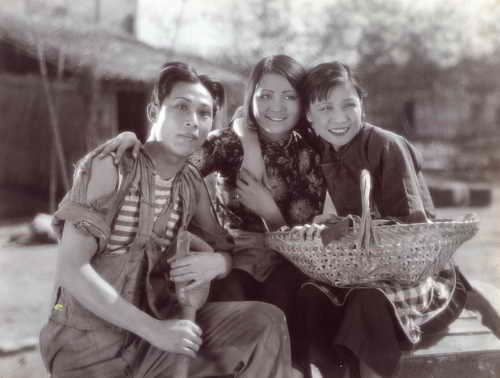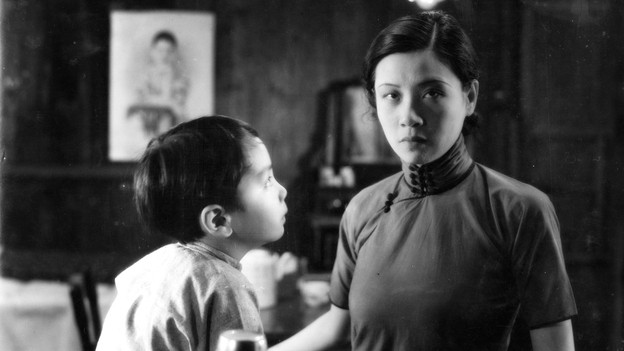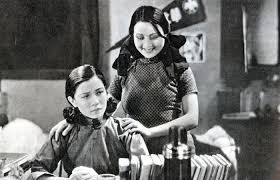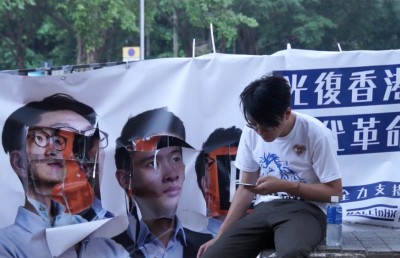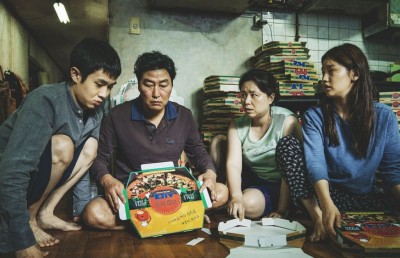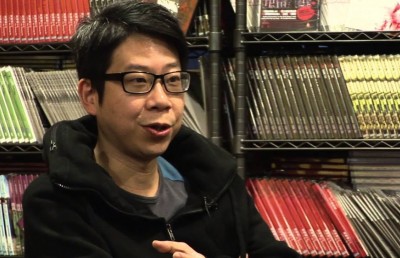The Tragic Life and Career of Ruan Lingyu
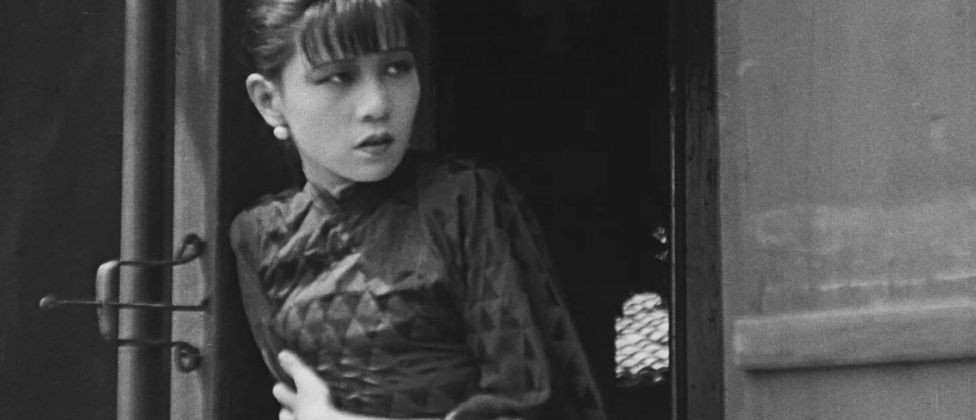
In February 1933, the Shanghai movie magazine The Star Daily ran a poll asking readers to name the “Queen of Chinese Cinema.” The winner, in a landslide victory of 21,344 votes, was the nation’s highest paid screen performer, Hu Die, 1 who starred in an approximate ninety movies over a span of forty-four years. Of those ninety titles, the vast majority are either lost or languish in obscurity. 10,028 votes went to Chen Yumei, roughly a year before the starlet married her boss at Tianyi Film Company and vanished from cinema screens. 2 Her films, too, have been largely forgotten. The third-place winner of this poll (with 7,290 votes) lived a shorter life and made fewer films than those preceding her, and yet has been immortalized as an international film icon. Of all the stars of Chinese silent cinema, Ruan Lingyu remains one of the most well-known decades later; the subject of numerous studies, documentaries, and dramatic reconstructions (including two television miniseries and a 1991 biopic directed by Stanley Kwan).
Debate persists as to how much of Ruan’s lasting popularity can be attributed to the fact that she committed suicide at the age of twenty-four. Around midnight on March 7, 1935 – after a long period of legal battles and being slandered in the press – the actress poured three bottles of sleeping pills into a bowl of congee, poisoning herself, and died in a hospital the following day. Her body lay in state in the Wanguo Funeral Home for nearly a week, observed by a crowd greater than that which had attended the wedding of Hu Die just eight months earlier. When the funeral procession began on March 14, an estimated 100,000 watched her casket being transported to Luen Yee Sayzoong Cemetery. A few admirers honored the late movie star by taking their own lives. (“If Ruan Lingyu is dead, what else is there to live for?” proclaimed one heartbroken follower. [Ling 133]) And in May of that year, the essayist Lu Xun published one of his most famous pieces, “Gossip Is a Fearful Thing,” named after a line in what was purported to have been one of Ruan’s suicide notes. 3
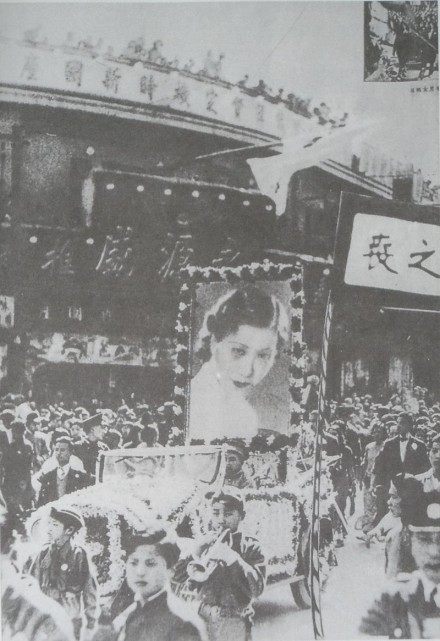
Ruan Lingyu’s funeral in 1935
Nearly four decades later, film historian Jay Leyda wrote in his 1972 book Dianying/Electric Shadows: An Account of Films and the Film Audience in China that the actress’s Chinese admirers “explain her special place in their memories as somehow attached to her tragic, early death in 1935.” (87) Later still, in a 2000 interview, the widow of actor Jin Yan attributed Ruan’s legacy surpassing her husband’s to “more publicity because she committed suicide.” (Meyer Jin-Yan 158) In offering a different perspective in 2010, the critic Paul Fonoroff cited Maggie Cheung’s award-winning portrayal of Ruan in the biopic Center Stage (Stanley Kwan, 1991) as “the catalyst that catapulted Ruan back into public consciousness.” While one could question the extent to which Fonoroff’s argument is true – six years before Center Stage, Asia Television Limited broadcast the first mini-series based on Ruan’s life, which scored record viewer numbers in Hong Kong and was quickly sold to Mainland China – the reception to Cheung’s performance has no doubt added to the phenomena keeping Ruan Lingyu alive in the minds of film lovers around the world.
Whatever the reason(s), the interest is not unjustified. In 1936, Ruan’s contemporary and occasional co-star Li Lili wrote: “Looking back now, I think the distinguishing feature of her performances was their believability, their extreme meticulousness. She had already realized that film acting wasn’t about ingratiating yourself with audiences or mechanically going through the range of emotions – but rather, penetrating the heart of a role and expressing that role’s emotional content.” (Griffithiana 137) Indeed, Ruan’s surviving films showcase an exceptional talent with a thorough command of movement and expression, qualities that made her ideal for silent cinema. (She never made any talkies.) But another fascinating quality to her acting that has helped preserve her appeal is how she came to represent proletarian suffering in times of great social upheaval. In contrast to the characters played by Li Lili, the most famous of whom tended to be symbols of optimism and progressive thinking, Ruan’s women personified victimization. They seldom took charge of their own destinies and, when on the rare occasion they did, suffered the pushback of a society turned against them.
Ruan Lingyu’s life coincided with a number of significant events in China’s early twentieth-century political history. She was born in 1910, a year before the Qing Dynasty was overthrown in the Xinhai Revolution. The May Fourth Movement of 1919, highlighted by public protests against foreign meddling in Chinese affairs, occurred during her days in primary school. The year she entered the film industry (1926) saw the nationalist Kuomintang (KMT) and the Chinese Communist Party (CCP) embarking on the Northern Expedition in an attempt to unify the country. While on location filming Luoyang Bridge (Zhang Shichuan, 1928), she learned the KMT had turned on its allies, killing thousands of communists and communist sympathizers nationwide. And in 1932, she witnessed the aftermath of Japanese naval attacks on Shanghai, partaking in public frustration with the KMT’s hesitancy to resist colonization.
It was during these chaotic years that Chinese filmmakers began reacting to the wrongs in their society, albeit in a very roundabout way. Because government censorship made it difficult to criticize the KMT, anti-conservative messages were typically hidden within the framework of simple tearjerkers. Rather than statesmen-esque heroes, the drama focused on victims in the lower classes and their mistreatment by social elitists and greedy capitalists; and to avoid the impression of promoting revolutionary behavior (which the censors associated with communism), the protagonists seldom lashed back at their oppressors. Not every filmmaker took this approach, but most leftist movies in 1930s China were tagged with unhappy endings, in effect revealing the consequences of KMT management without (openly) blaming the government or (openly) calling for change.
Ruan Lingyu was one of the key movie stars featured in these films. In her earliest surviving film, Love and Duty (Bu Wancang, 1931), she plays the daughter of a rich conservative family who falls in love with a commoner but cannot be with him because her father has already chosen a suitor from their own class. One of the most successful domestic releases of 1931, this film came not long after a post-May Fourth Movement surge in literature contrasting independent young people marrying for love and less courageous individuals somberly obeying the practice of arranged marriage. Both phenomena are reflected in the film. Initially surrendering to her family’s decision, Ruan enters a passionless marriage; years later, she re-encounters her beloved and abandons matrimony to be with him. He in turn succumbs to an illness and the heroine spends the rest of her days as a seamstress, cast into the slums by a family unwilling to forgive her. Because of the melodramatic framework and numerous scenes of tear-shedding, censors deemed Love and Duty pure sentiment, paying little attention to its negative outlook on conservative customs, with a young woman being punished for not following tradition. (Part of the irony being that her husband, too, was guilty of infidelity.)
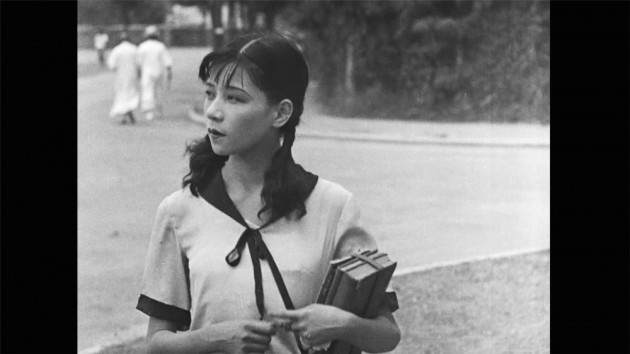
Ruan Lingyu in Love and Duty (1931)
In another extant film from that year, The Peach Girl (Bu Wancang, 1931), Ruan and her Love and Duty co-star Jin Yan again expose the plight of the lower classes via romantic tragedy. This time, Jin plays the son of a wealthy landlord and Ruan the servant whom he wishes to marry. Caste-oriented drama blooms when Jin’s mother refuses to let him wed someone lower on the social hierarchy. In both of these pictures, the bridges between rich and poor are amended on a note of sadness: only upon the death of the quietly suffering heroine do the tradition-based elitists realize their errors. Ruan and Jin had previously enacted the ‘‘rich boy, poor girl’’ scenario in Wild Flower (Sun Yu, 1930), though that film ended happily, with the couple staying together in spite of their parents’ disapproval. Love and Duty and The Peach Girl, with their gloomy denouements, reveal the suffering of those not audacious enough to break the status quo. Even less cheerful was City Nights (Fei Mu, 1933), in which Ruan lovelessly surrenders her body to Jin Yan (here, the son of a land developer) in exchange for the delayed demolition of her family’s neighborhood. Women sexually victimized by “civilization” remained a theme in the actress’s subsequent works. In Goodbye, Shanghai (Zheng Yunbo, 1934), she was a rural schoolteacher who comes to the city, only to be drugged and raped by a lecherous doctor.
The image most associated with Ruan Lingyu all these years later remains that of the misunderstood, suffering prostitute, no doubt because of her best known role, in The Goddess (Wu Yonggang, 1934). The title refers to a Shanghai euphemism for prostitutes, who at the time accounted for approximately one-thirteenth of the city’s female populace. First-time director Wu Yonggang had observed such women while working as a set designer and initially set out to make a painting that captured his sympathy for them. Although the painting was never finished, the image stayed in his head, and he eventually converted the idea into a script. The Goddess tells the story of a single mother who sells her body in order to put her child through school. Despite her best efforts, she’s unable to find respectable work; her money is routinely stolen by a gangster and neighbors petition the school to have her son expelled. Pushed to the breaking point, she kills the gangster in a fit of rage and is sent to prison, torn away from her son by the society which has always been against her. Like many of the films previously mentioned, The Goddess does not offer a solution to the problems it depicts. In so doing, it demonstrates the key difference between Ruan Lingyu’s usual screen image and that of her earlier mentioned colleague, Li Lili.
Li had played a sex worker in Daybreak (Sun Yu, 1933), one of the more leftist films of the ‘30s, and her character responds to mistreatment with activism, becoming a revolutionary and proudly facing a firing squad for her cause. By contrast, Ruan, at the end of The Goddess, entrusts the care of her son to his former headmaster, asking that the child be told his mother’s dead; this way, he’ll be free of prejudice the rest of his life. After a fleeting moment of happiness, imagining her son leading a better life, the eponymous goddess turns toward the camera, somber and dejected from the loneliness she will experience henceforth. This conclusion feels like a spiritual prologue to Life (Fei Mu, 1934), an unrelated earlier film of Ruan’s about a prostitute whose child is taken away. That picture ended with the streetwalker, years later, as an old woman, gazing through a window at her now grown son, knowing she must not approach him. One imagines a similar fate for the heroine of The Goddess.
Many of the plot elements from these films, such as poverty, rape, and societal hostility, eerily mirrored dark moments in Ruan’s personal life. Born to poor Cantonese parents, she was evicted from her home at the age of three, so that her father’s employer could transform the neighborhood into a golf course. When she was sixteen, it became necessary for her to drop out of school and help her now widowed mother make ends meet. Around this time, she entered into a common law marriage with the son of her mother’s former employer, Zhang Damin, who according to historian Richard J. Meyer “won the body and heart” of the actress when they were still adolescents. This was a euphemism meaning that he raped her. (Meyer Ruan Ling-Yu 12) And because of her popularity in the ‘30s, the press relentlessly detailed the lows in Ruan’s personal life; on top of that, elitist writers continually lambasted the acting profession, which they deemed little better than the sex trade. A 1927 article in Women’s Journal classified movie actresses as: those with no other means of earning a living; those lured by the promise of money; unprincipled prostitutes seeking fame; and registered prostitutes tired of selling their sexual services. In a sense, the image of the quietly suffering woman regularly battered by society wasn’t too far removed from the woman who played her.
Negative perception toward people like Ruan was depicted, in a very condemning manner, in her penultimate film, New Women (Cai Chusheng, 1934). Inspired by the 1934 passing of actress/screenwriter Ai Xia, the film’s story also bears more than a few similarities to tribulations Ruan Lingyu had gone through herself. Like Ruan, the heroine comes from an impoverished background and ventures to Shanghai to make a living in the arts (in this case, as a music teacher). Abandoned by an uncaring husband, she pulls herself out of poverty, only to be hurled back into it by a society unwaveringly hostile toward women. She is relentlessly pursued by a lecherous man, who, with the signing of a cheque, arranges to have her fired, and then exploited by a newspaper after rebuffing the advances of an editor. 4 Ultimately, the music teacher commits suicide via an overdose of sleeping pills; an ending that, while modeled on the death of Ai Xia, anticipates Ruan’s own fate in 1935 and further recalls her previous, unsuccessful, attempt to end her life in the late ‘20s.
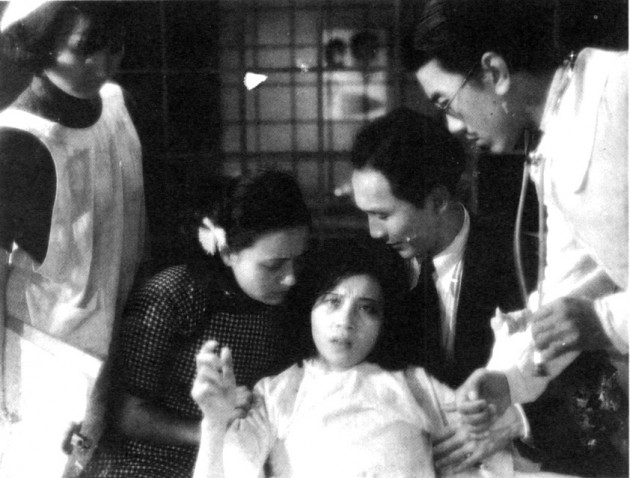
Ruan Lingyu in New Women (1934)
Having overdosed on sleeping pills once before, performing the suicide scene proved devastating for Ruan, as recounted by Li Lili, who happened to be visiting the set that day: “[S]he didn’t show much expression, she just gazed as she swallowed one pill after another. However, the look in her eyes underwent a subtle change, showing all the contradictory emotions of a suicidee at the moment when her life hangs in the balance, and expressing her thirst for life and dread of death, her indignation and sorrow . . . Her acting in this scene was extremely draining and afterwards she couldn’t stop crying for most of the day. Everyone on the set was also deeply affected and caught up in the tragic atmosphere. Afterwards I asked her, ‘At the moment you took the sleeping pills, what were you thinking of?’ . . . She said, ‘Unfortunately, I’ve also been through a similar experience, but I didn’t die. When doing the scene, I experienced all over again the state of mind I was in when I tried to commit suicide. In that split second, your feelings are all confused: I felt like freeing myself from all the pain of living, but instead I just added to it. Many people’s faces appear in front of your eyes, among them those you most love and hate. When I swallowed each sleeping pill, I had to find a new way to make my emotions well up.’” (Griffithiana 137)
Of course, not all Ruan Lingyu films were without uplift. Upon reading the script for Three Modern Women (Bu Wancang, 1933), the actress was so taken by its anti-establishment themes that she begged the film’s director to let her be in it. In this lost melodrama (another case of a straightforward leftist film that did not try to hide its political message), Ruan played the fiancée in an arranged marriage who, after her betrothed flees to Shanghai seeking fame, involves herself with the impoverished. Her fiancé turns up in the hospital where she volunteers (having been wounded at the battlefront), and she brings him down to earth by personally escorting him around the slums, awakening him to the existence of the poor. Maintaining its fearless support of leftist ideology, the picture ended with a labor strike.
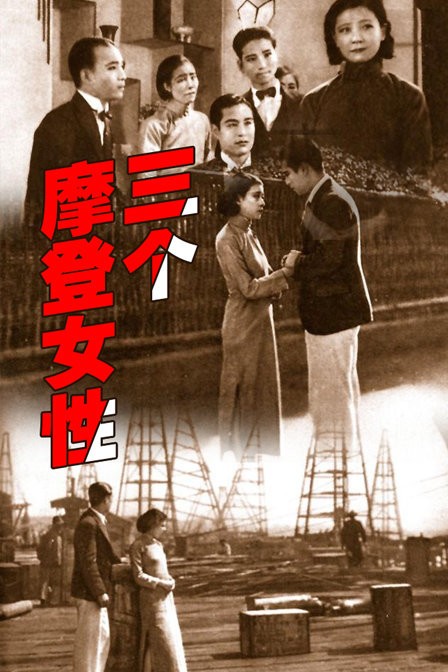
Poster for Three Modern Women (1933)
Little Toys (Sun Yu, 1933), still extant today, was an exceptionally popular film for its positive depiction of national pride. Audiences still reeling from the Japanese naval attacks of 1932 recognized this picture as one representing their interests, personified by a toymaker mother and daughter whose lives are first disrupted by foreign competition (imported toys) and later thrown into chaos by an invading country that goes unnamed, but is clearly meant to be Japan. Li Lili plays the daughter and embodies her usual inspiring persona, encouraging physical fitness and patriotism among the common people. The mother, played by Ruan, turns revolutionary at the end, after the daughter’s been killed in a raid, standing amid a Shanghai crowd and calling upon everyone to band together and repel the enemy. At one point, she speaks directly to the camera (the audience) demanding the same of them. While director Sun Yu wasn’t able to call out the Japanese by name, thanks to the KMT stubbornly insisting that Chinese communists were more dangerous than invading armies, the point behind the scenes of bombardment and devastation was not lost on moviegoers and intellectuals.
In National Customs (Luo Mingyou and Zhu Shilin, 1935), the last picture she made before her death, Ruan became an inspiring political figure once more, albeit for a very different ideology. This time, she embodied straight-up government propaganda. By the mid-’30s, it had become clear the censors could only be fooled so much. Appalled by the message of Three Modern Women, they dispatched personnel to demolish the studio of screenwriter Tian Han; between November 1934 and March 1935, 83 scripts were rejected for filming; the KMT forced banks to decline loans to studios with suspected communists under employment; Ming Xing Film Company produced a Hu Die picture with a message that Lu Xun described as: “Be content with poverty” (Sergeant 265); and more films were made promoting what the government called the New Life Movement. As described by Richard J. Meyer, National Customs was among those films advocating “a renewal of traditional culture and ethics while condemning Shanghai’s evil influence on the youth of the nation. In a call for a return to Confucian virtues of propriety, right conduct, honesty, and integrity, the party in power believed that those values required obedience to authority.” (Meyer Ruan Ling-Yu 51) This time, it was up to Ruan Lingyu to encourage Li Lili to give up “frivolous” behavior and become an “honorable” person.
In a sense, it is amusing that Ruan Lingyu’s career should end with this particular film. In years past, she’d starred in pictures cleverly voicing reservations with the status quo; now, at the tail end of her filmography, she became a blatant propaganda tool to please the KMT and champion their ideas of public peace. Her death in March 1935 also predated a technological sea change in her nation’s cinema. Just four years earlier, Ming Xing released the first Chinese talkie, Sing-Song Girl Red Peony (Zhang Shichuan, 1931); and while sound was initially slow in reaching mainstream status in China (due to the majority of film distributors being reluctant to upgrade their theaters), it was clear the days of silent movies were numbered.
As the years went by, more and more Chinese theaters renovated with sound-projecting equipment, and Mandarin was quickly selected as the official dialect of motion pictures. This was of little consequence to stars like Hu Die and Li Lili, both of whom grew up around Beijing, but a major roadblock for Ruan Lingyu. Her native dialect was Cantonese, her Mandarin less than perfect, and her speech tinged with a Guangzhou accent. Cinematographer Huang Shaofen told Harriet Sergeant the coming of sound caused Ruan to worry her career would be affected, and, like many of her characters, she would be impoverished all over again. While she made no mention of this in either of her suicide notes, it might have been on her mind when she fatally poisoned herself.
Ruan Lingyu acted in twenty-nine movies, twenty of which have been swept away by poor preservation and catastrophic damage inflicted by World War II (which, alas, has wiped out so much of early cinema throughout Asia). 5 Because she passed away in the midst of major changes in her industry, one cannot help but wonder what might have occurred had she lived a little longer. We can only speculate whether she would have remained a poster girl for nationalism; whether she could have successfully adapted to sound; whether she would have stayed in China or left for Hong Kong following the 1949 revolution; or whether she would have been persecuted during the Cultural Revolution, as many of her colleagues were. However, a sizable portion of her work from the early-to-mid ‘30s survives, displaying her remarkable command of film acting and empathy-stirring characterization of the suffering proletarian, both of which render her a figure worthy of careful study to this day.
Bibliography
Fonoroff, Paul. “Ruan Lingyu,” South China Morning Post, 6 June 1910
Lehman, Peter, and Davide Turconi (ed). Griffithiana, 60/61. Udine: La Cineteca del Friuli (October 1997)
Hershatter, Gail. Dangerous Pleasures: Prostitution and Modernity in Twentieth-Century Shanghai. Berkeley, London, and Los Angeles: University of California Press, 1997
Hjort, Mette. Stanley Kwan’s Center Stage. Hong Kong: Hong Kong University Press, 2006
Leyda, Jay. Dianying/Electric Shadows: An Account of Films and the Film Audience in China. Cambridge: The MIT Press, 1972
Ling, Pan. In Search of Old Shanghai. Hong Kong: Joint Publishing Co., 1982
Lu Xun. “Gossip Is a Fearful Thing,” in Selected Works of Xu Lun, Vol. 4. Peking: Foreign Language Press, 1960
Meyer, Richard J. Jin Yan: The Rudolph Valentino of Shanghai. Hong Kong: Hong Kong University Press, 2009
Meyer, Richard J. Ruan Ling-Yu: The Goddess of Shanghai. Hong Kong: Hong Kong University Press, 2006
Pang, Laikwan. Building a New China in Cinema: The Chinese Left-Wing Cinema Movement, 1932-1937. Lanham: Rowman & Littlefield Publishers, Inc., 2002
Sergeant, Harriet. Shanghai: Collision Point of Cultures 1919-1939. New York: Crown, 1990
Yang, Jeff. Once Upon a Time in China. New York: Atria Books, 2003
Zhang, Yingjin (ed.). Cinema and Urban Culture in Shanghai, 1922-1943. Stanford: Stanford University Press, 1999
Notes
- Hu’s salary at Ming Xing was two thousand yuan a month, about twenty times the amount earned by most Chinese film actresses and eight times the salary of China’s highest paid male star, Jin Yan. ↩
- Chen’s husband was Runje Shaw. His siblings would go on to establish Hong Kong’s famous Shaw Brothers production company. ↩
- As it turns out, the suicide note containing this quote had been forged at the order of Ruan’s then lover, tea merchant Tang Jishan. A second set of suicide notes revealed Ruan had in fact been suffering physical abuse from Tang and that he’d beaten her the night she committed suicide. ↩
- At the time of the film, Ruan Lingyu and Zhang Damin had legally separated, but he regularly slammed her with lawsuits and threats of libel, all of which made for popular material in the tabloids. ↩
- Ruan’s nine extant films:_ Love and Duty_ (Bu Wancang, 1931), A Spray of Plum Blossoms (Bu Wancang, 1931), The Peach Girl (Bu Wancang, 1931), Little Toys (Sun Yu, 1933), Coming Home (Zhu Shilin, 1934), Goodbye, Shanghai (Zheng Yunbo, 1934), The Goddess (Wu Yonggang, 1934), New Women (Cai Chusheng, 1934), and National Customs (Luo Mingyou and Zhu Shilin, 1935). ↩

